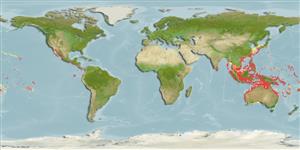>
Eupercaria/misc (Various families in series Eupercaria) >
Labridae (Wrasses) > Corinae
Etymology: Halichoeres: Greek, als, alis = salt + Greek, choiros = pig (Ref. 45335).
More on author: Bleeker.
Environment: milieu / climate zone / depth range / distribution range
Ecología
marino asociado a arrecife; rango de profundidad 10 - 70 m (Ref. 12472). Tropical
Western Pacific: tropical, north to southern Japan; may ultimately be regarded as a subspecies of Halichoeres zeylonsis of the Indian Ocean. Also recorded from Indonesia, Mentawai Island (Ref. 5978).
Tamaño / Peso / Age
Maturity: Lm ? range ? - ? cm
Max length : 18.0 cm TL macho / no sexado; (Ref. 9002); peso máximo publicado: 82.64 g (Ref. 124708)
Short description
Claves de identificación | Morfología | Morfometría
Espinas dorsales (total) : 9; Radios blandos dorsales (total) : 11; Espinas anales: 3; Radios blandos anales: 11. Juveniles are off-white with a broad yellow lateral band.
Inhabits seaward reefs, prefers open expanses of sand or mixed sand, rubble, and pavement usually below 11 m. Occurs in loose groups of one male and numerous smaller females and juveniles. Small groups of females and males moving over large areas by themselves, regularly checking females (Ref. 48636).
Life cycle and mating behavior
Maturities | Reproducción | Spawnings | Egg(s) | Fecundities | Larva
Distinct pairing during breeding (Ref. 205).
Myers, R.F., 1991. Micronesian reef fishes. Second Ed. Coral Graphics, Barrigada, Guam. 298 p. (Ref. 1602)
IUCN Red List Status (Ref. 130435)
Threat to humans
Harmless
Human uses
Pesquerías: comercial; Acuario: Comercial
Herramientas
Special reports
Download XML
Fuentes de Internet
Estimates based on models
Preferred temperature (Ref.
123201): 24.3 - 28.9, mean 27.7 °C (based on 514 cells).
Phylogenetic diversity index (Ref.
82804): PD
50 = 0.5000 [Uniqueness, from 0.5 = low to 2.0 = high].
Bayesian length-weight: a=0.00955 (0.00451 - 0.02020), b=3.09 (2.92 - 3.26), in cm total length, based on LWR estimates for this Genus-body shape (Ref.
93245).
Nivel trófico (Ref.
69278): 3.5 ±0.5 se; based on size and trophs of closest relatives
Resiliencia (Ref.
120179): Alto, población duplicada en un tiempo mínimo inferior a 15 meses (Preliminary K or Fecundity.).
Fishing Vulnerability (Ref.
59153): Low vulnerability (10 of 100).
Nutrients (Ref.
124155): Calcium = 73.2 [44.4, 120.5] mg/100g; Iron = 0.681 [0.404, 1.233] mg/100g; Protein = 18.4 [15.6, 20.6] %; Omega3 = 0.165 [0.108, 0.252] g/100g; Selenium = 28.8 [17.7, 49.2] μg/100g; VitaminA = 132 [41, 493] μg/100g; Zinc = 1.59 [1.11, 2.49] mg/100g (wet weight);
